Texting & SMS marketing statistics in 2024
We surveyed 1,400 consumers and businesses to glean key texting insights for 2024. Here's what we found.
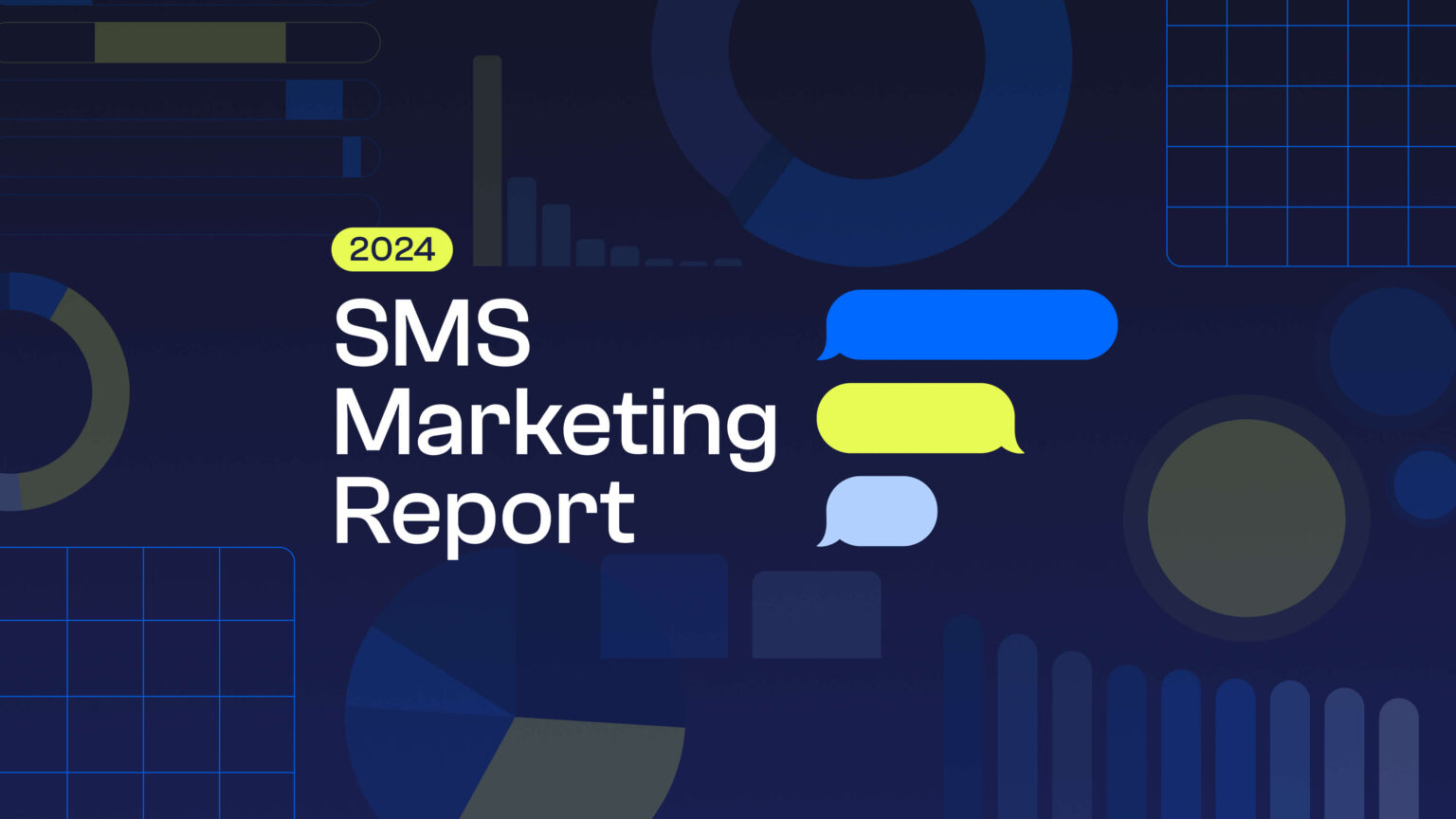
We surveyed 1,400 consumers and businesses to glean key texting insights for 2024. Here's what we found.

45% more businesses are using SMS marketing now compared to this time two years ago.
In a world where attention is the new currency, businesses are upping their game, using SMS not just as a way to shout into the void, but as a strategic tool to engage their customers where they already are.
Whether it’s used for VIP sales access, real-time feedback loops, important event reminders, or gentle nudges about the lonely items in consumer carts, SMS is proving its might as a multifaceted marketing powerhouse.
As this marketing channel continues to grow, we’re thrilled to unveil SimpleTexting’s fifth annual SMS marketing report. We surveyed 1,400 consumers, business owners, and digital marketers to understand how these parties view and use SMS in 2024.
First, we asked consumers about their mobile habits when it comes to texting, screen time, and two-way communication with businesses.
Then we asked business owners and marketing managers about texting adoption, successful use cases, AI integration, and SMS marketing conversion rates in 2024.
So, what percentage of businesses are texting their customers, and what do SMS opt-in rates look like today across industries? Cue the drumroll and dig into the latest insights below to find out.
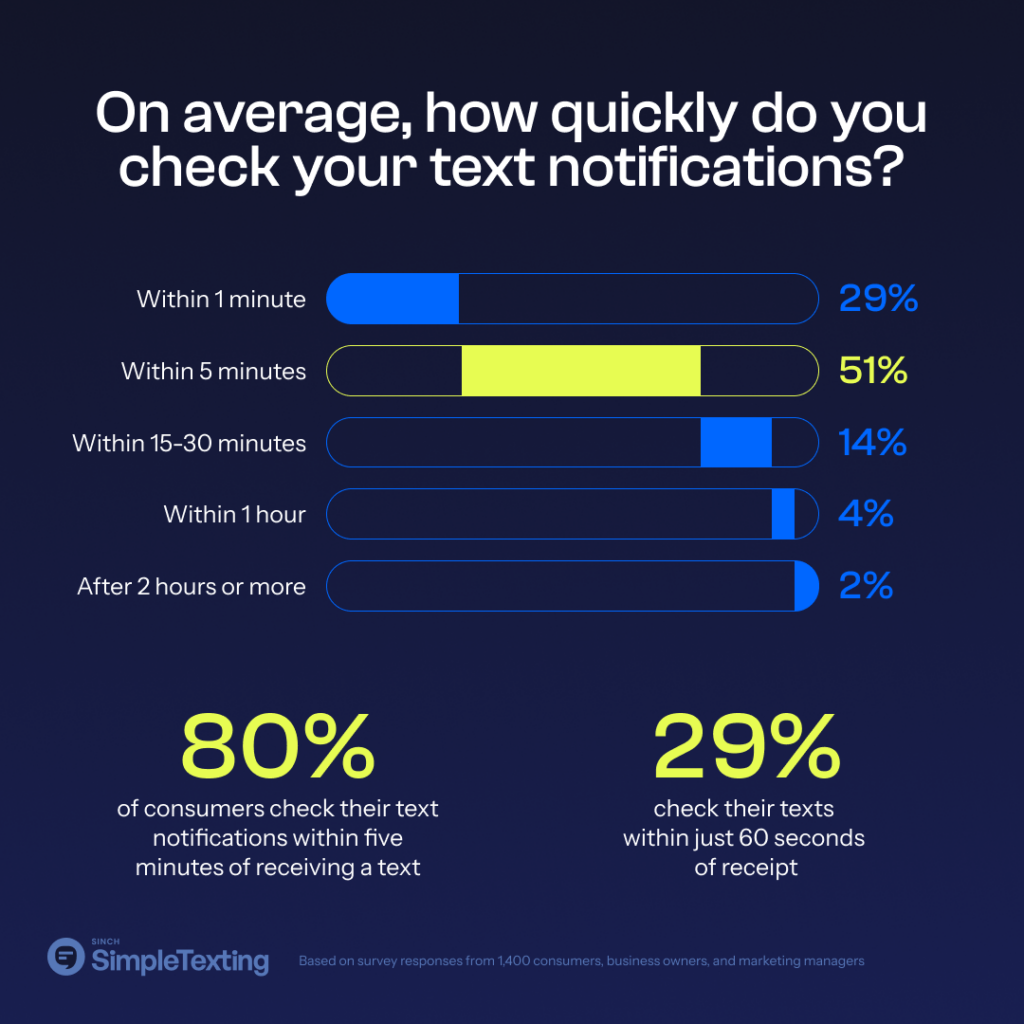
When it comes to checking text notifications, consumer responsiveness is swift. Nearly 30% of consumers check their text notifications within just 60 seconds of receipt, and a staggering 80% check their text notifications within just five minutes of receiving a text.
Even for those who take a bit longer, the majority are still quite prompt. Around 14% of consumers check their text notifications within 15 to 30 minutes of receiving a text.
This lightning-speed engagement is great news for businesses who use SMS, ensuring that your message doesn’t just arrive, but is seen and considered almost instantly.
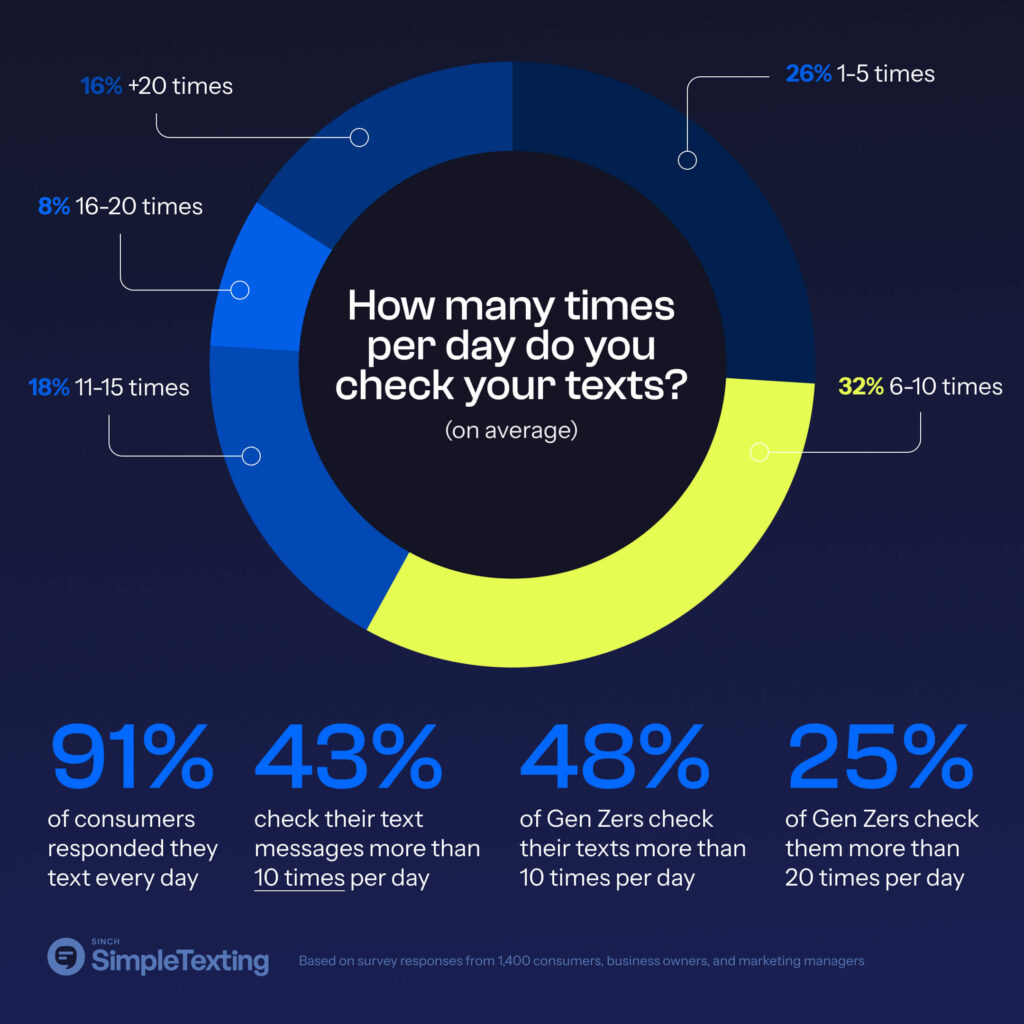
In a world where consumers often skip YouTube ads, remove pop-ups, and quickly scroll past social media blasts, capturing the attention of your audience can be quite an uphill battle.
Enter SMS marketing: where texts put your brand squarely in front of your customers using a medium they’re already engaged with and invested in. 91% of consumers text every day, and 43% of consumers check their text messages more than 10 times per day.
As many companies wish to target younger generations, we found that Gen Zers are glued to their texts and group chats. 48% of Gen Zers check their text messages more than 10 times per day, and aquarter of Gen Zers (25%) check their messages more than 20 times per day.
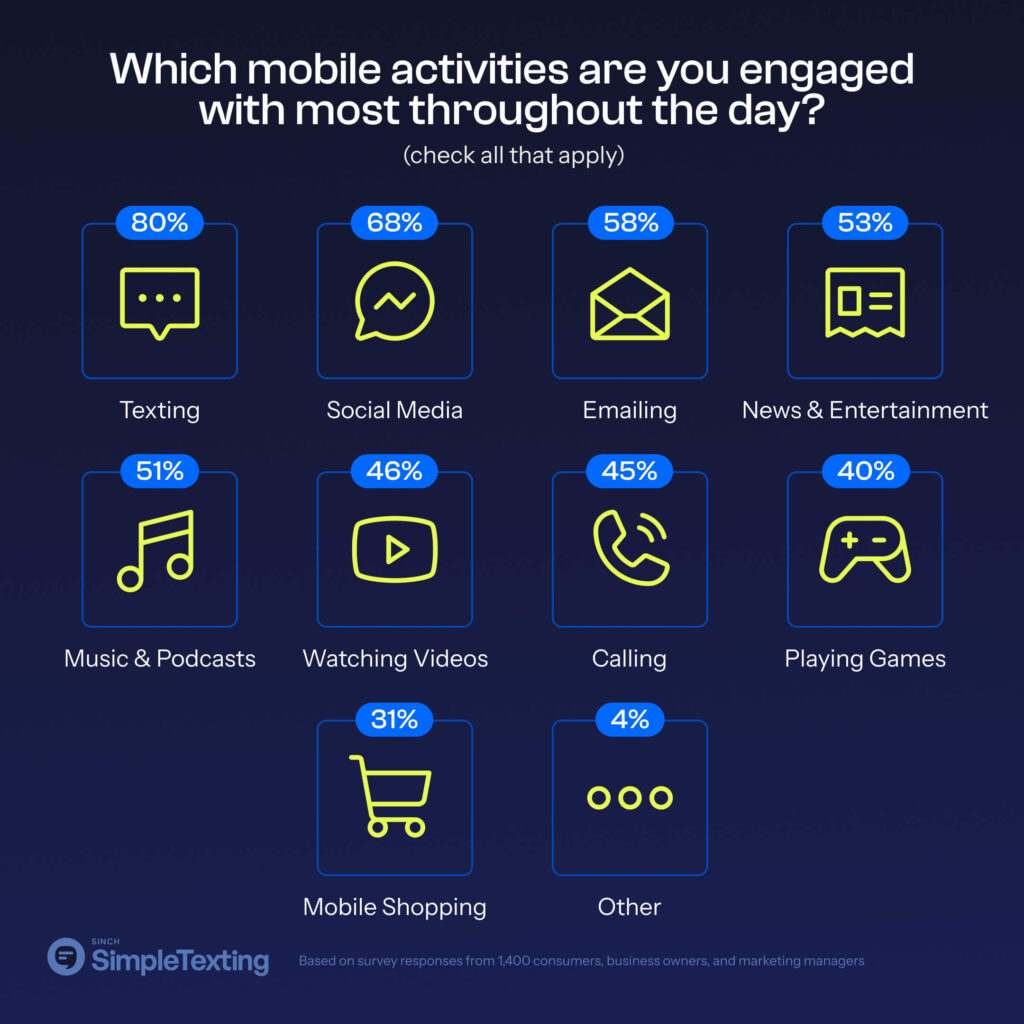
On an average day, people prioritize checking their text messages over any other app on their phones. 80% of consumers report texting as their primary mobile activity, surpassing other popular activities like social media (68%), emails (58%), news or entertainment (53%), and music or podcasts (51%).
This insight highlights text messages’ impressive user engagement, establishing it as a prime channel for businesses to effectively reach their target audience.
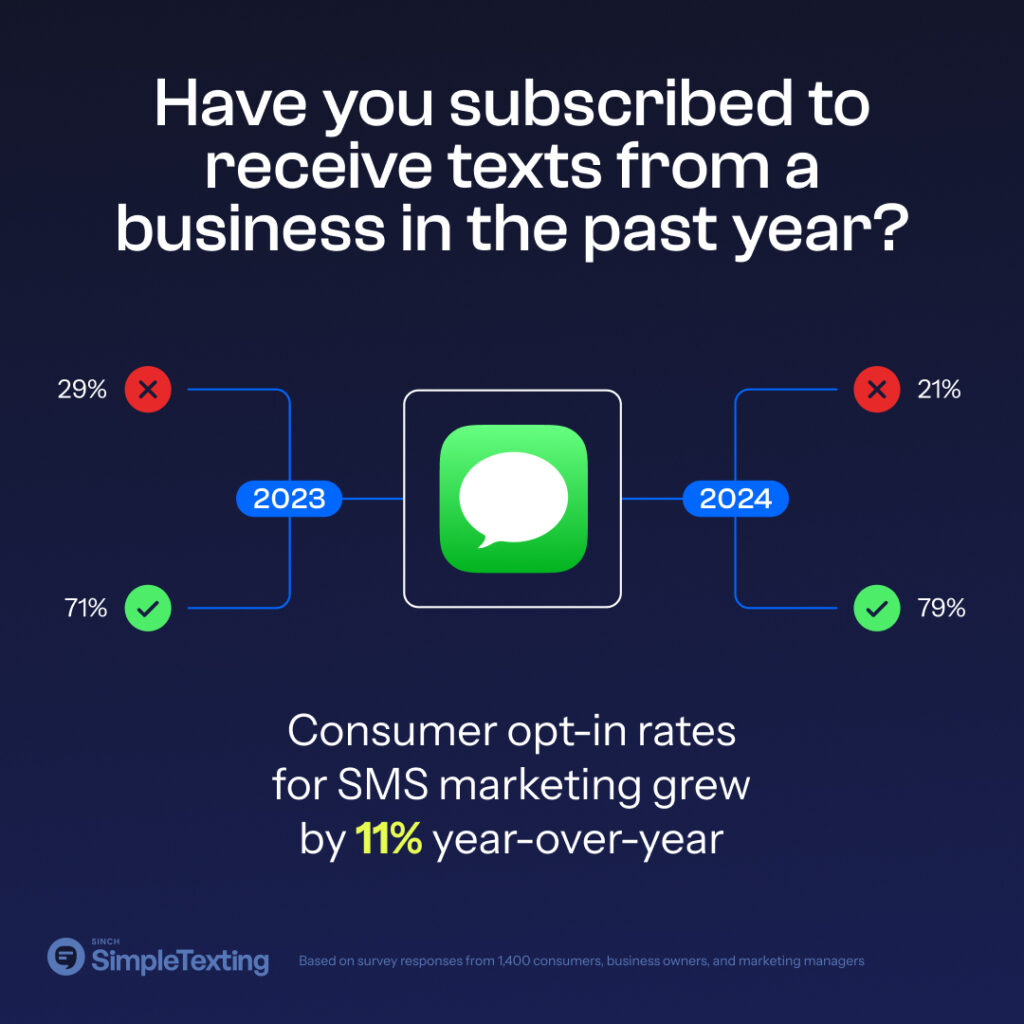
In 2024, people want direct communication with businesses. 79% of consumers are opted in to receive texts from businesses. In our 2023 report, 71% of people subscribed, indicating an 11% growth in consumer SMS marketing opt-ins year over year and a growing preference for text-based communication from brands.
Here’s how the insights shake out by different demographics: more women (84%) are opted in to receive texts from businesses than men (73%) and Gen Z is the generation subscribing to SMS marketing the most. 85% of Gen Zers are currently opted in to receive texts from businesses –– 19% more than last year. By comparison, 78% of millennials and 81% of Gen Xers opt in to SMS.
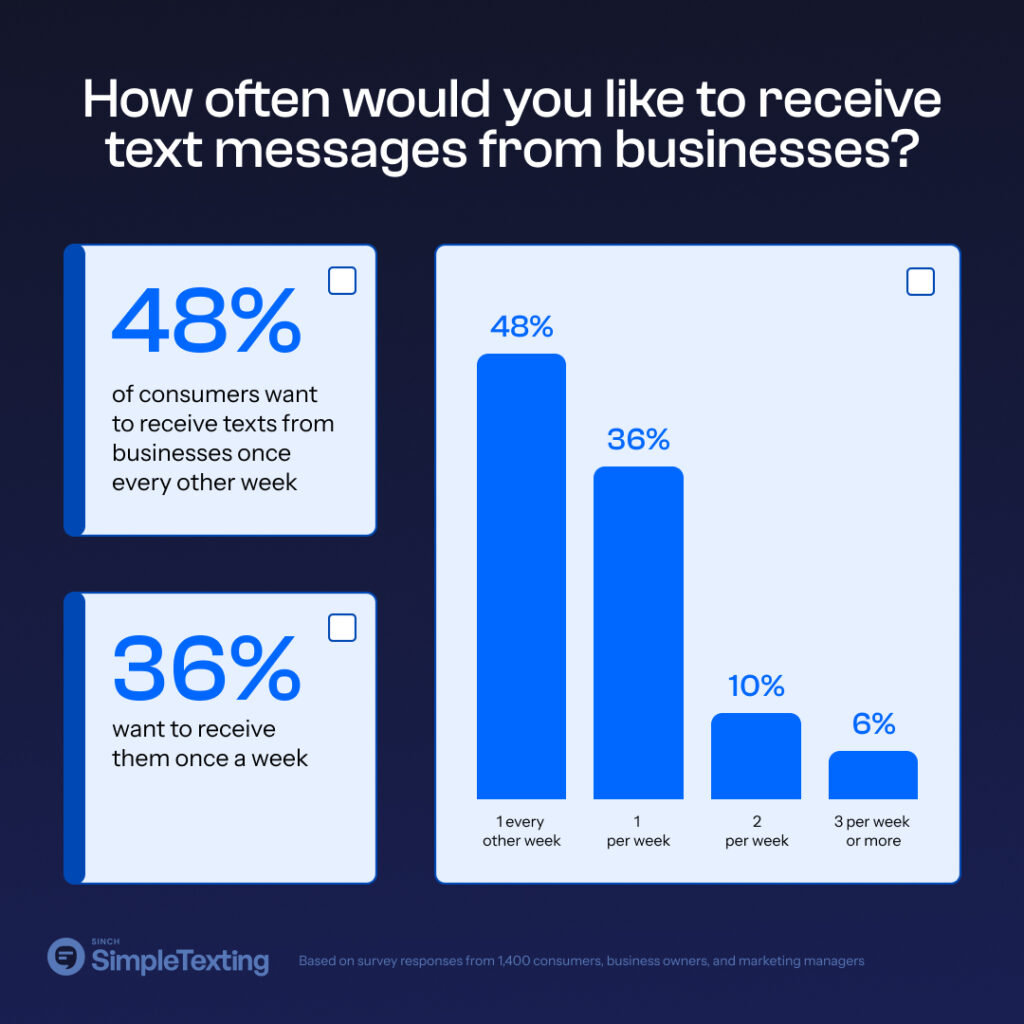
There is still untapped potential within SMS marketing. Most SMS subscribers currently receive texts from 1-3 businesses, but are willing to opt in to texts from 4-6 businesses, signaling an unclaimed territory ripe for businesses ready to differentiate themselves and deepen customer loyalty through text messaging.
When it comes to text message cadence, no one wants to feel spammed. Most SMS subscribers (48%) want to receive texts from businesses once every other week, followed by 36% who say once a week, 10% who say twice a week, and a modest 6% who say three times per week or more.
Interestingly, even though more women opt in to business texts than men, men are open to receiving business texts more frequently than women –– 41% of men want to receive texts from businesses once a week. Only 32% of women say the same.
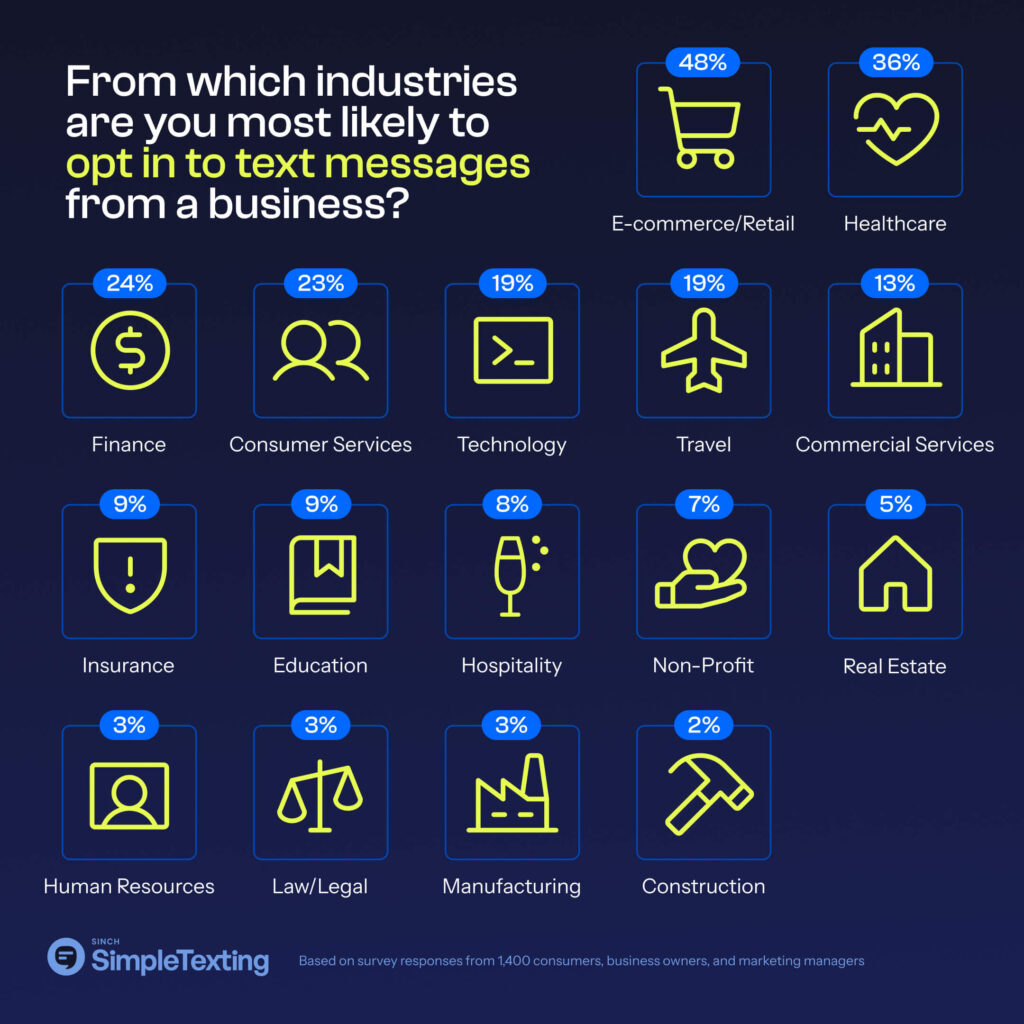
Consumers are most likely to receive texts from companies in e-commerce/retail (48%), followed by healthcare (36%), and finance (24%). Text message marketing can help e-commerce and retail businesses attract new customers, send personalized store promotions, reduce cart abandonment, and provide two-way customer support. With SMS for healthcare, businesses can improve patient communication, send appointment reminders, reduce no-shows, and instantly attend to urgent patient requests.
Notably, there has been a significant increase in e-commerce and retailed-related opt-ins compared to last year’s report. In 2023, e-commerce/retail accounted for 46% of SMS opt-ins, indicating a 4% growth in e-commerce and retailed-related opt-ins year over year.
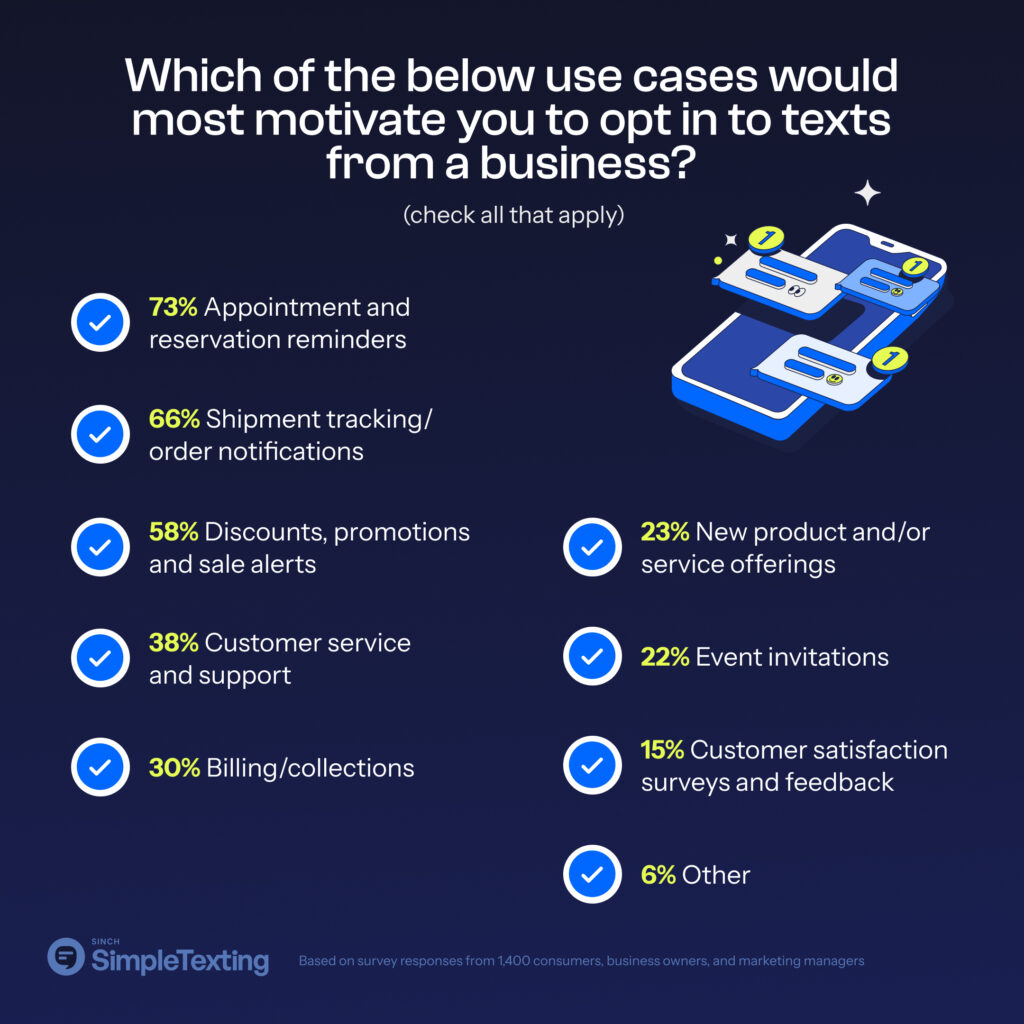
The driving forces behind consumers’ growing enthusiasm for opting into business texts are clear. Appointment/reservation reminders (73%), shipment tracking/order status (66%), and promotions/sale alerts (58%) are the three most common reasons why consumers subscribe to SMS. Convenience, timely access to deals, and efficient post-purchase experiences are compelling consumers to sign up.
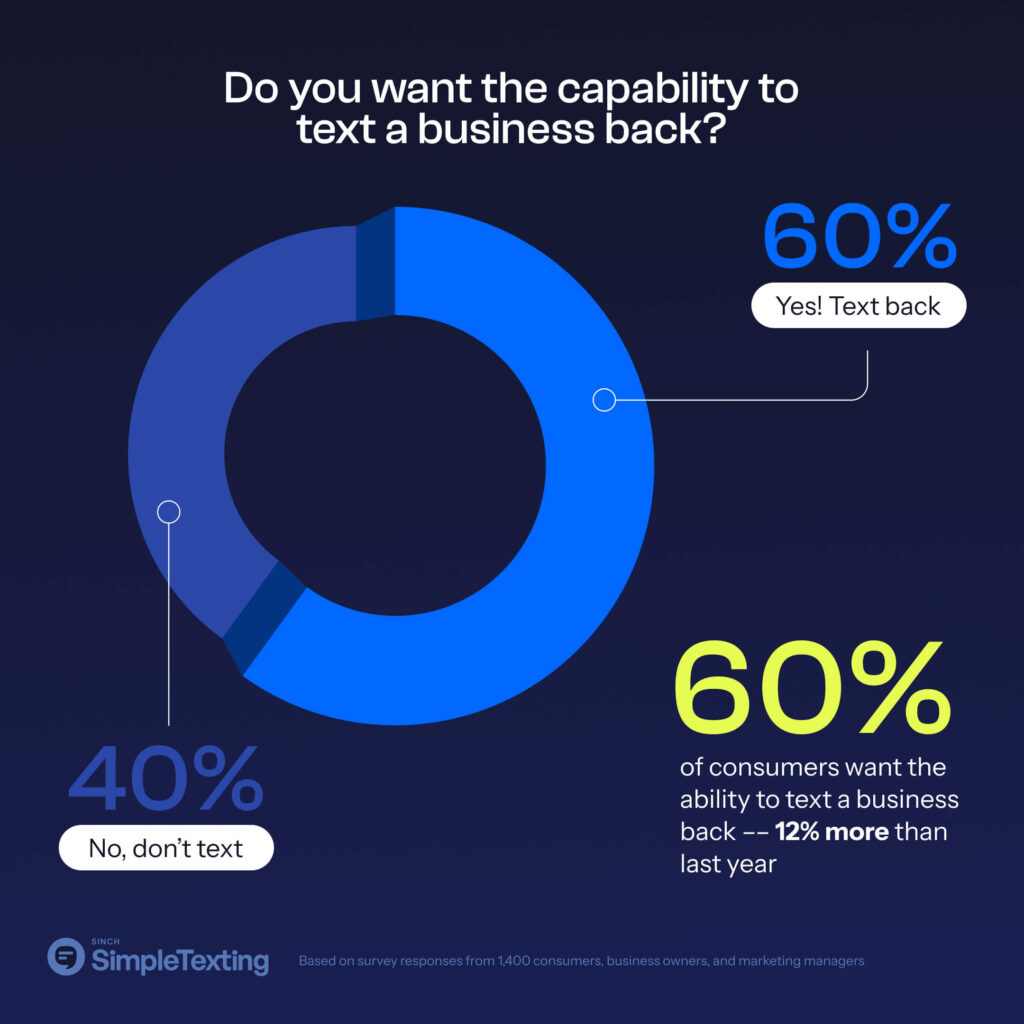
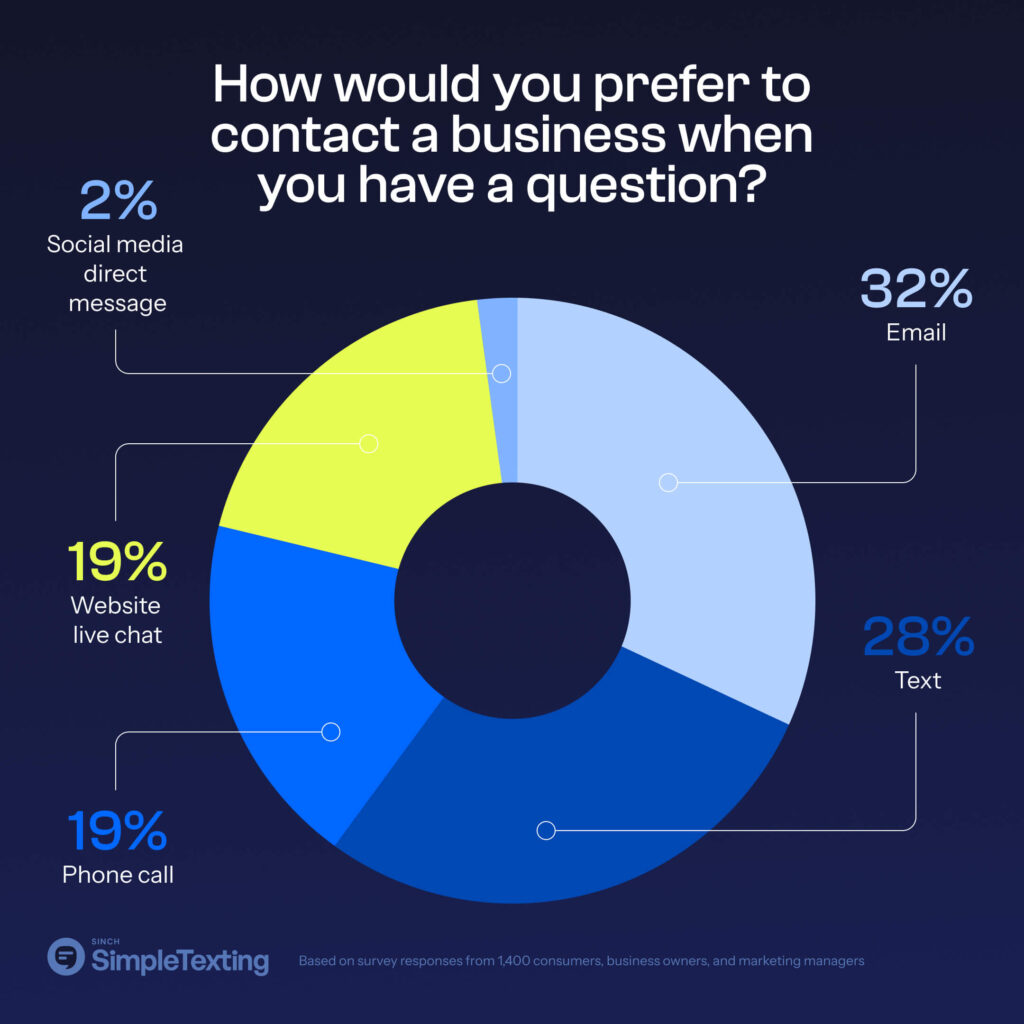
The majority of consumers value two-way conversations with businesses, particularly when it comes to customer support. 60% of consumers say they want the ability to text a business back –– 12% more than last year’s report, where 53% of consumers wanted text-back capability.
When it comes to customer service, consumers prefer texting less than email, but more than phone calls or live chat.
When asking consumers, “How would you like to contact a business when you have a question,” the largest share of consumers (32%) prefer emailing a customer service representative.
Texting is a close runner-up (28%), followed by phone calls (19%), live chat (19%), and social media messages (2%).
But the results shift when we zoom in on specific demographics. For instance, Gen Zers and men prefer texting over all other contact methods for their customer service inquiries.
The way we communicate is evolving, and nowhere is this more evident than in our professional and personal transactions. We asked consumers how they would prefer to communicate with a recruiter when applying for a job, for things like interview scheduling, checking on their application status, and more. 26% of Gen Zers and 20% of people overall prefer texting with a recruiter over emailing or calling.
When it comes to house hunting, even more people are hopping on the texting bandwagon. When asked how they would prefer to communicate with a real estate agent for things like scheduling showings and submitting offers, the largest portion of consumers (40%) name texting as their preferred contact method.
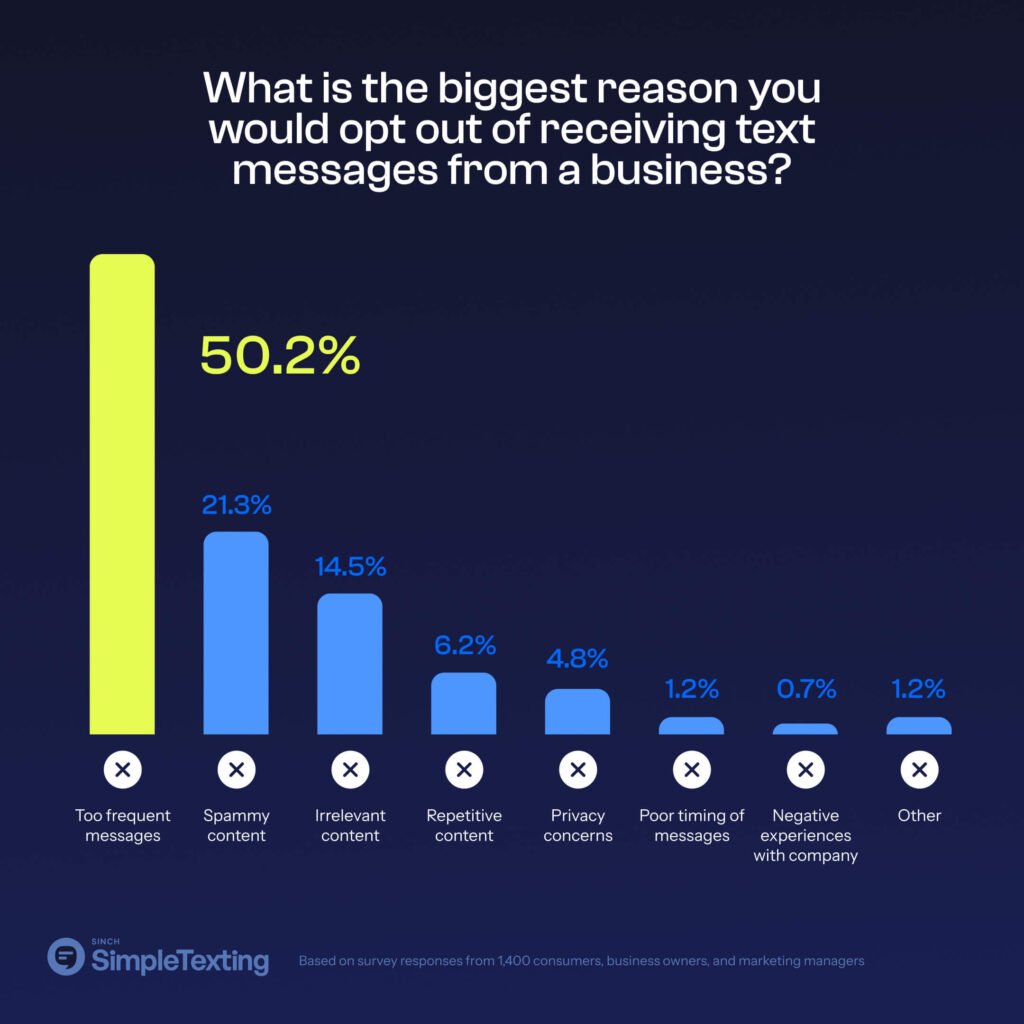
63% of consumers say that businesses that text them provide them with a better overall customer experience than those that don’t. However, there’s a fine line between engaging and overwhelming.
The primary deal-breakers leading consumers to unsubscribe from business texts include messaging too frequently (50%), spam-like content (21%), and messages that lack relevance (14%). This stat underlines the importance of balance and customization in text marketing strategies to maintain customer satisfaction.
A good rule of thumb for businesses: avoid bombarding consumers with too many texts and set expectations from the jump. Upon opting in, consumers should be informed about the frequency of messages they can expect to receive from a brand each month.
📌Save this for later: How often to text? 5 cadences we suggest to 17,000+ businesses
Another piece of advice: steer clear of texts that feel spammy. Before hitting send, take a moment to consider if your message reads as though there’s a genuine person behind it. Messages that pass this human touch test are far more likely to elicit responses or clicks from customers.
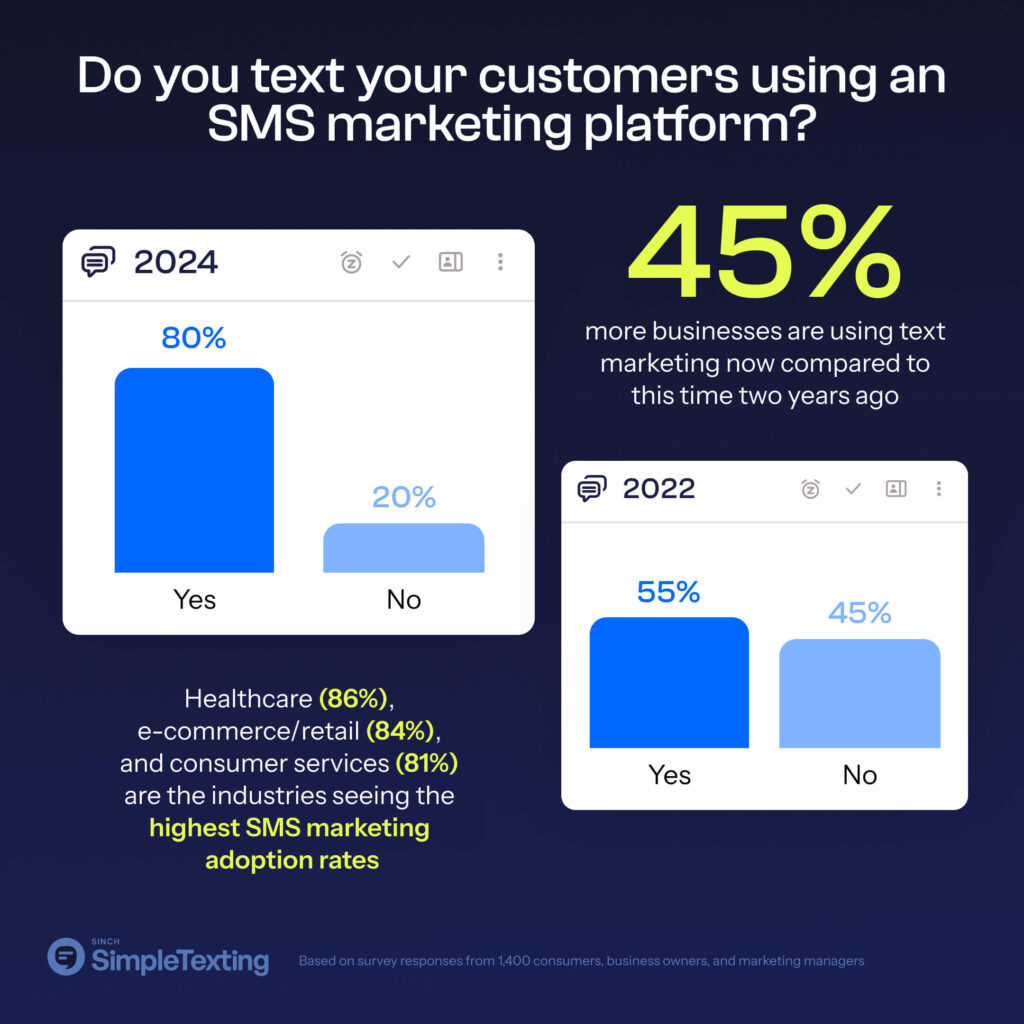
Texting is now a widely used digital marketing channel. 80% of businesses are using SMS marketing software to text their customers in 2024. In 2022, 55% of businesses were using SMS marketing, so 45% more businesses are using text marketing now compared to this time two years ago. That may be because many small business are discovering that SMS marketing is very affordable, effective, and an efficient way to handle day-to-day customer communications.
Healthcare (86%), e-commerce/retail (84%), and consumer services (81%) are the industries seeing the highest SMS marketing adoption rates. What’s more, 69% of business owners and digital marketing managers plan on increasing their text marketing budget in 2024.
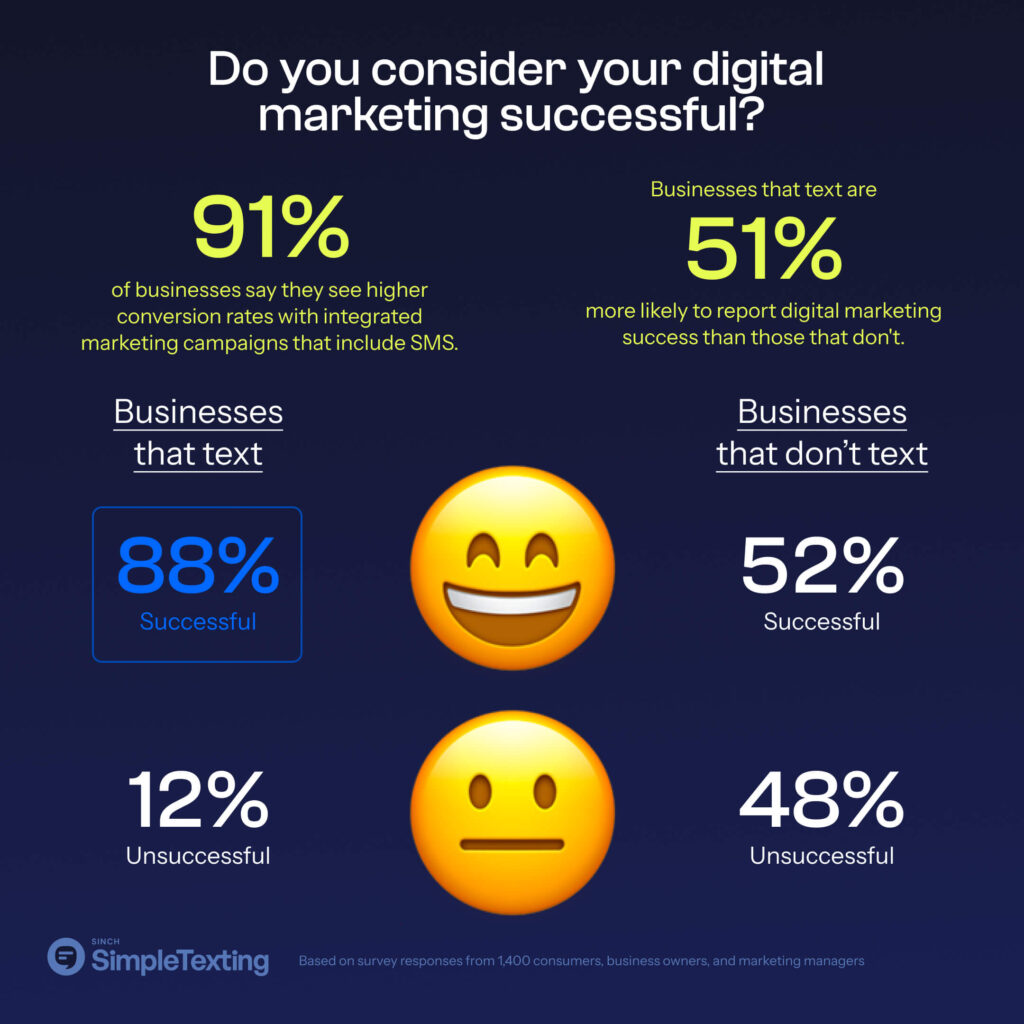
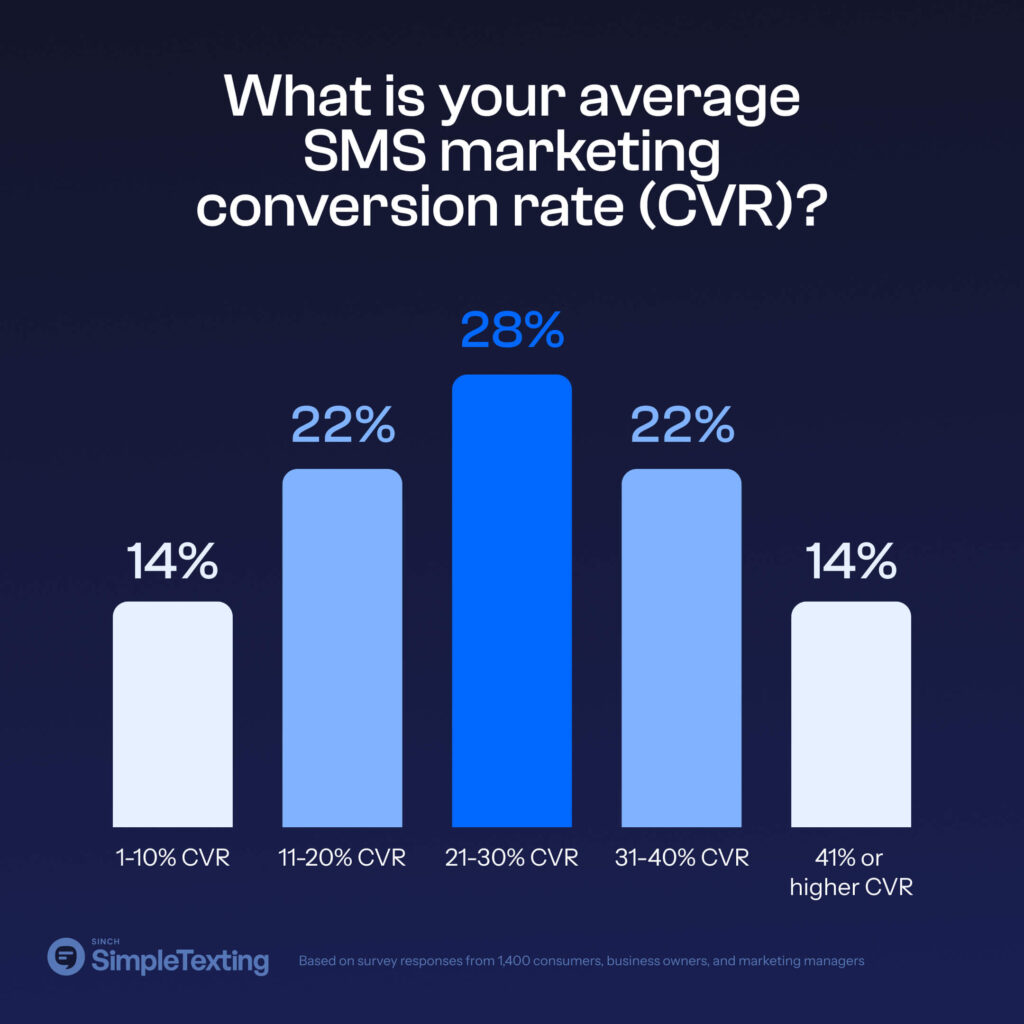
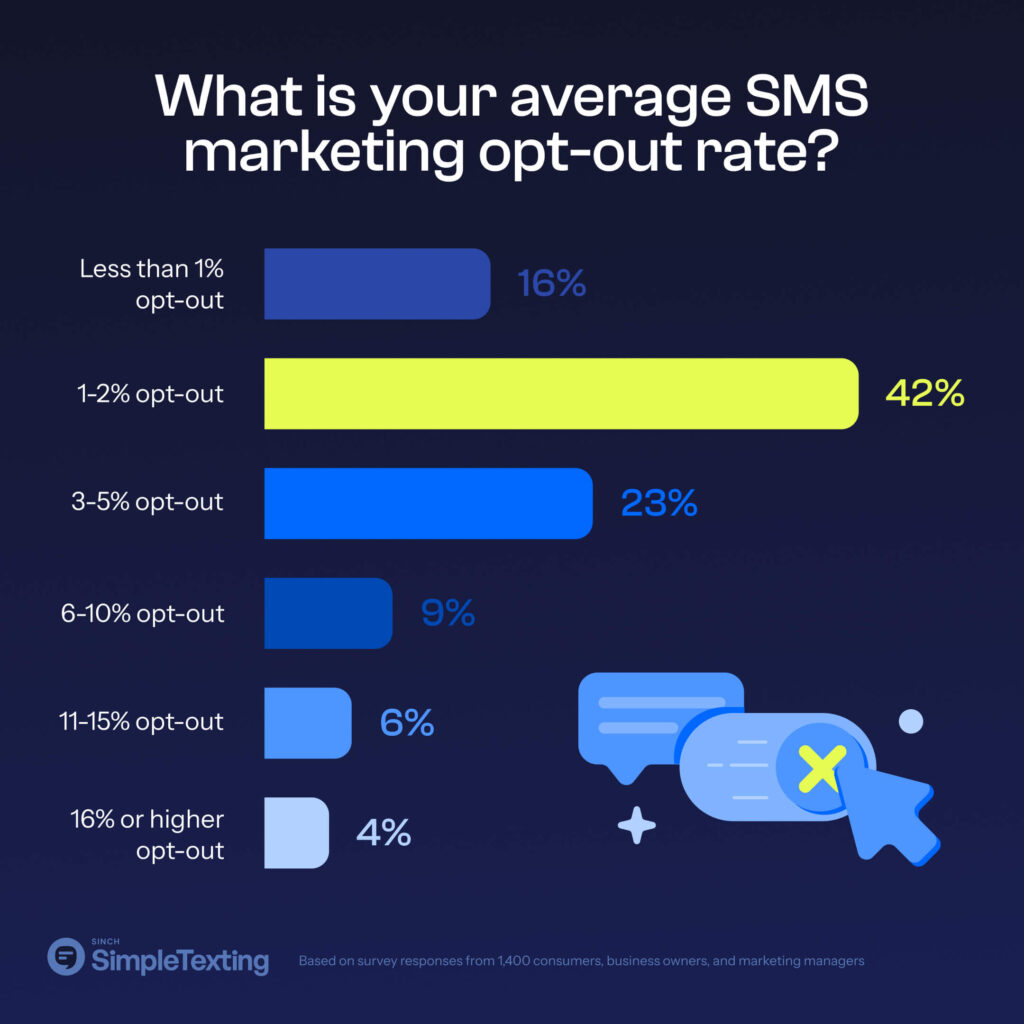
Incorporating SMS marketing into your overall digital marketing mix can make all the difference, and the stats are in to prove it. 87% of businesses that text report their digital marketing is successful, but only 49% of businesses that don’t text say the same.
So businesses that text are 683% more likely to report digital marketing success than those that don’t.
When it comes to cross-channel integration, 78% of businesses are integrating their text marketing with other digital marketing and CRM platforms like Mailchimp, Hubspot, and Salesforce. Businesses leveraging this cross-channel approach are 20% more likely to report digital marketing success than those that aren’t.
They’re also more likely to see higher conversion rates from their marketing efforts. 91% of business owners and marketing managers say they see higher conversion rates with integrated marketing campaigns that include SMS.
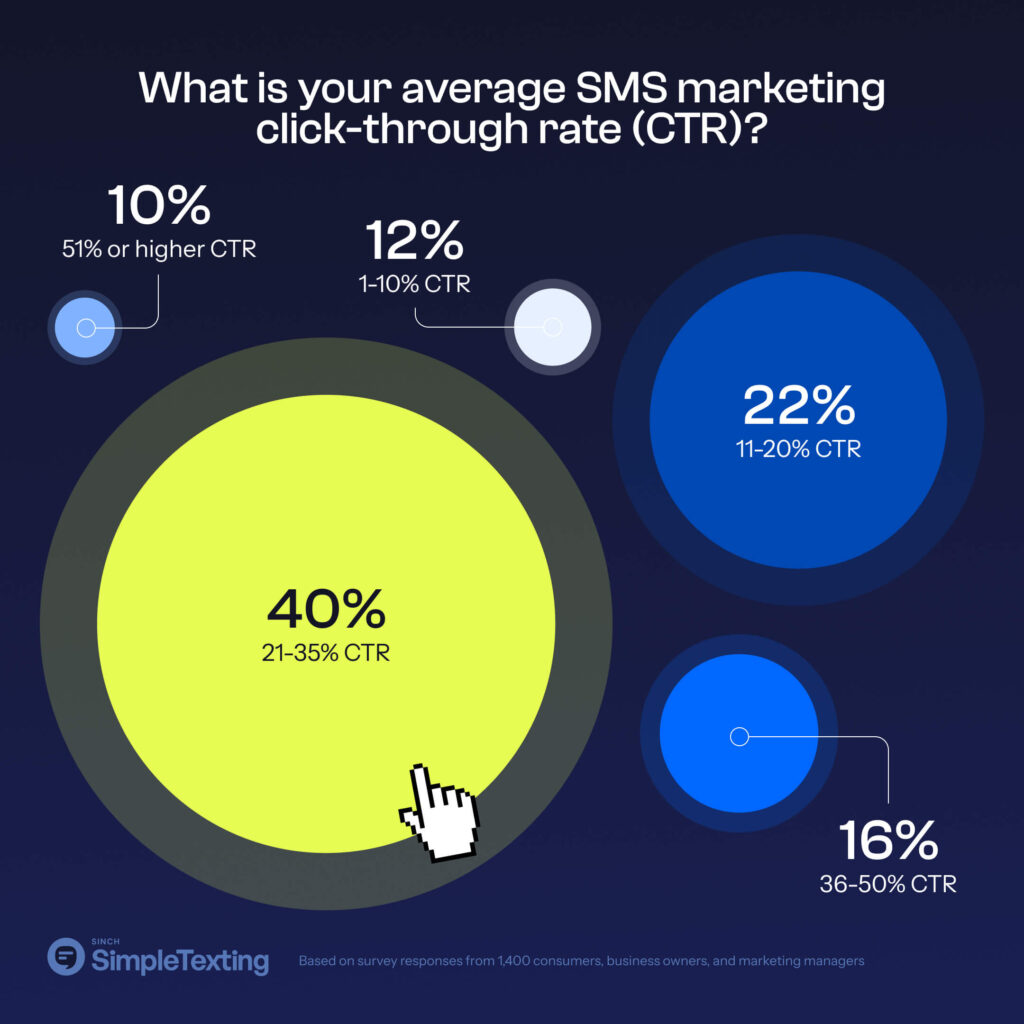
In 2024, the majority of businesses (40%) have an average text marketing click-through rate between 21 and 35%, with businesses in the healthcare industry leading the charge. A staggering 83% of healthcare businesses see average click-through rates higher than 20%.
Moreover, click-through rates are steadily rising over time, as more businesses adopt SMS marketing. The percentage of businesses whose average click-through rates are higher than 35% ballooned by nearly 62% between 2021 and 2024.
When it comes to converting those clicks into concrete results, the majority of businesses are seeing SMS marketing conversion rates between 21 and 30%, with finance and healthcare businesses at the forefront. 81% of finance businesses and 79% of businesses in healthcare see average SMS conversion rates higher than 20%.
Amidst the flurry of engagement and conversions, businesses are keeping their audiences happy and opted in. Most businesses have an average SMS marketing opt-out rate between 1 and 2%. The vast majority of businesses (81%) have average opt-out rates under 5%.
Even more impressive, 16% of businesses have average opt-out rates under 1%.
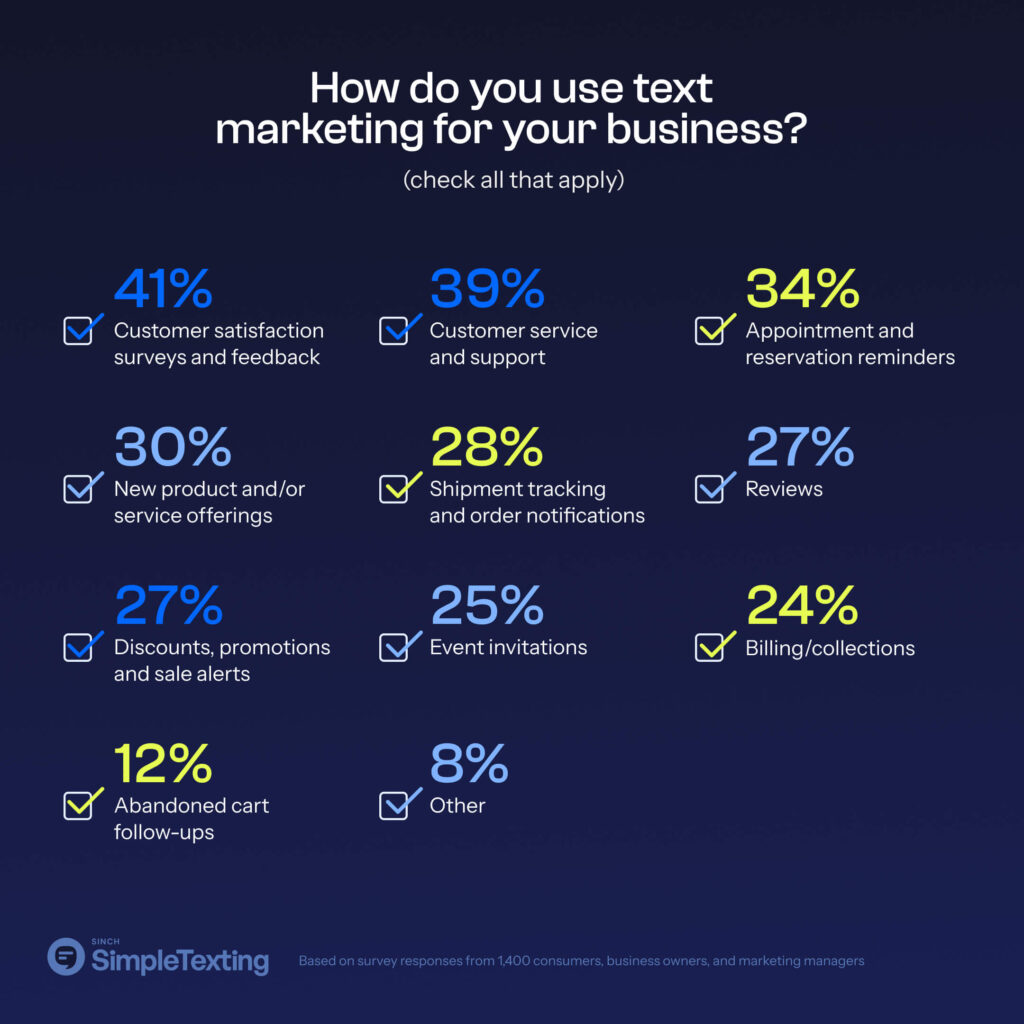
In the past, the go-to uses for SMS marketing revolved around promotions, special offers, and managing billing or collections. Fast-forward to 2024, and there’s a noticeable shift.
Now, businesses are prioritizing customer satisfaction surveys (41%) and customer service/support (39%) as their top reasons for sending texts. This evolution highlights a deeper dive into enhancing customer experiences and building stronger relationships with customers.
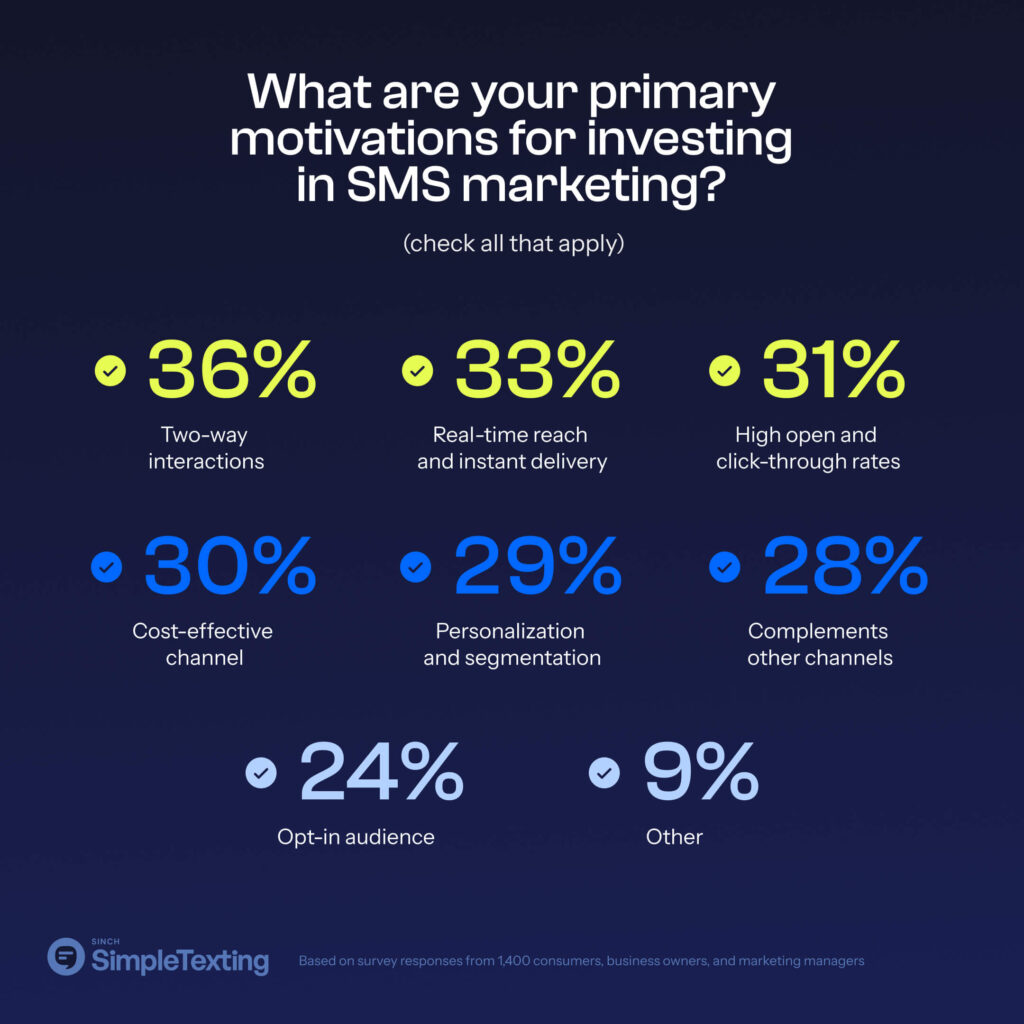
The largest share of businesses (36%) name two-way interactions as the biggest benefit of using SMS marketing. Two-way texting between customer service representatives and customers not only personalizes the customer experience, but also opens the door to real-time feedback, queries, and resolutions, making every text an opportunity to build loyalty. Other top motivations for investing in SMS are real-time reach and instant delivery (33%), and high open/click-through rates (31%).
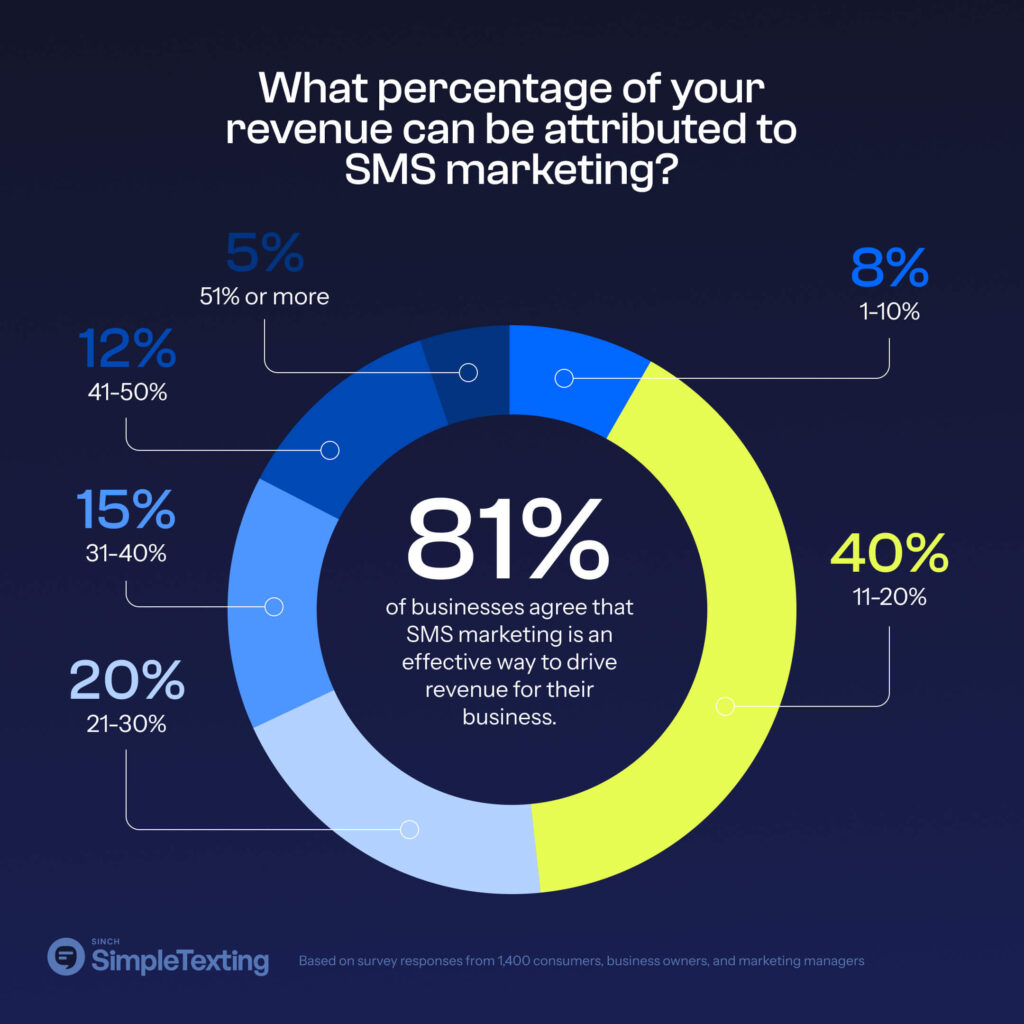
The lion’s share of businesses (81%) agree that text message marketing is an effective way to drive revenue for their business, and the majority of businesses (40%) say 11 to 20% of their revenue can be attributed to SMS.
This isn’t just a nod to the effectiveness of texting as a marketing channel; it’s a loud and clear endorsement of its role as a critical revenue generator.
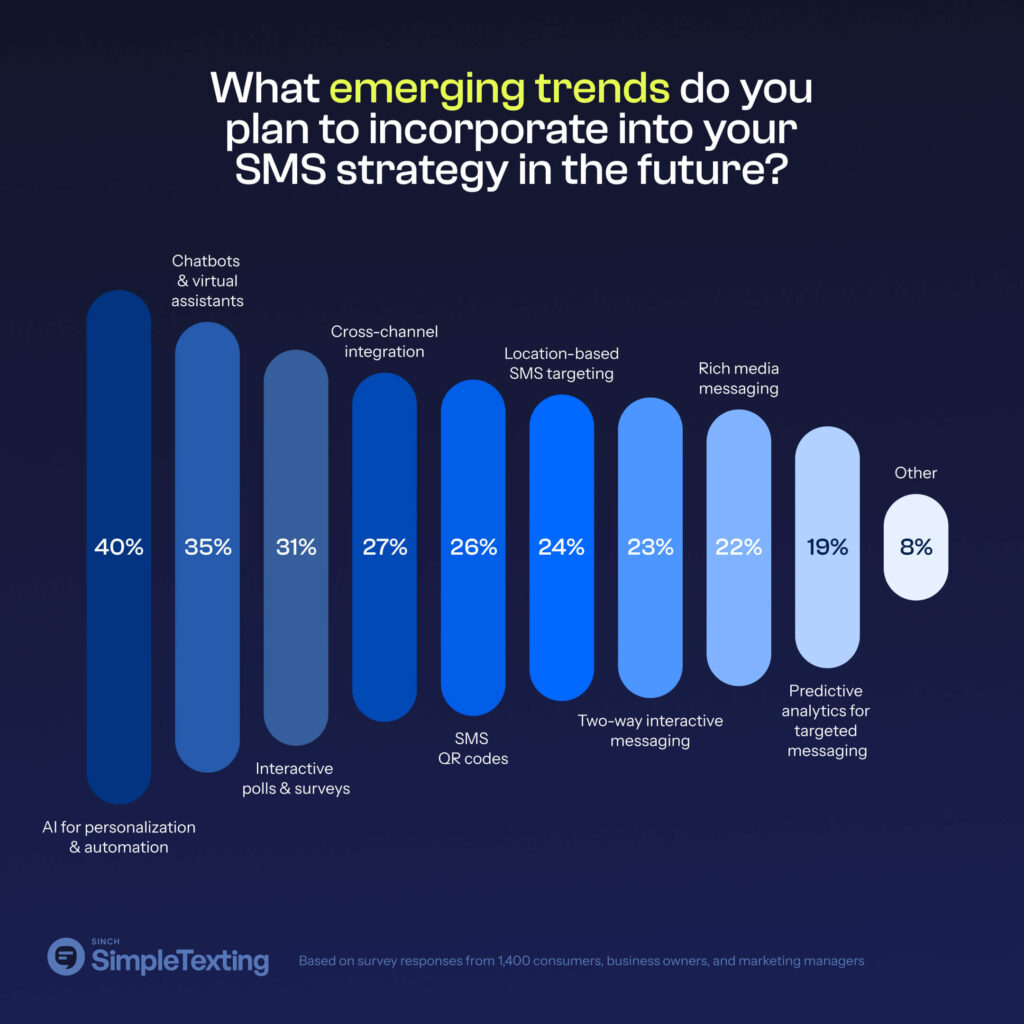
Using AI for personalization and automation (40%) is the most popular SMS marketing trend for businesses in 2024. Today, businesses can use generative AI to write text messages that create real value for their customers, have a clear call to action, and represent their brand.
Following closely are chatbots/virtual assistants (35%) and interactive polls/surveys (31%). Together, these trends underscore a dynamic shift towards more interactive, intelligent, and customer-centric SMS marketing approaches.
SMS marketing doesn’t seem to be slowing down any time soon. Companies are leveraging AI in their SMS marketing strategies, opt-in rates continue to rise, and industries like healthcare, e-commerce, and retail are using SMS to their advantage.
Check out our success stories spanning various industries, showcasing how SMS marketing has empowered both small business owners and corporations to connect effectively with their target audiences. Another good source of inspiration is our small business podcast where we work one-on-one with customers to help them solve their marketing challenges. Interested in starting your own SMS campaign or engaging customers through two-way texting? Try us out for free today!
The statistics in this report are derived from two separate surveys. We surveyed 1,000 U.S. consumers across a range of demographics and regions, and 400 U.S. business owners and marketing managers across a range of industries and company sizes from December 20th to 22nd, 2023. Interested in SMS marketing statistics from previous years? View our 2022 and 2023 SMS marketing reports.
Nathan is the head of content and SEO at SimpleTexting. With the help of an awesome team, he’s attracted more than 65 million website visitors, converted 10 million email subscribers, and supported 300,000 software users. He's written for the likes of Fast Company and his work has been referenced in publications like Forbes. Nathan has 15 years of proven corporate and startup marketing experience and continues to venture off the beaten path. When he’s not marketing, you’ll catch Nathan canoeing in the Boundary Waters or training for his next ultra marathon. Connect with Nathan on LinkedIn.
More Posts from Nathan ElleringNew data: 90.09% of businesses that use text messaging report their marketing is successful, according to proprietary research of 400 brands.
ReadLearn the latest on short code updates in Canada as well as what your options look like beyond them.
ReadStart a text marketing campaign or have a 1-on-1 conversation today. It's risk free. Sign up for a free 14-day trial today to see SimpleTexting in action.
No credit card required